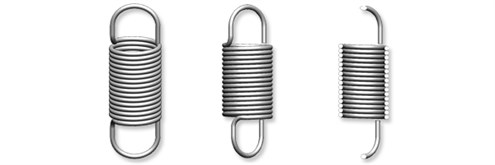What is an extension spring?
An extension spring can both absorb and store energy, as well as create resistance to a pulling force.
Extension springs often have a loop or hook at the end for mounting the spring. An extension spring is in most cases mounted on other objects that are in motion. When these objects move, the extension spring attempts to bring the objects back to their start position.

Initial force in extension springs
An extension spring is wound so that there is an initial tension in the coils that holds the coils against one another and thus tightly together.
This initial force (also called initial tension) is the force that must be overcome to set the extension spring in operation, thus it must be pulled so much the coils are no longer touching.
All standard extension springs are wound with initial tension. The initial tension is not guaranteed to be uniform for different production runs. If precise initial tension is required, or consistent initial tension, it is possible to make a special extension spring that meets the desired requirements. It is possible to make an extension spring with almost no initial tension and long travel as a result, or a high initial tension and short travel as a result
Construction, environment, installation factors and operating conditions all determine how the extension spring should be dimensioned to achieve maximum performance.
The force of an extension spring is linear apart from the introductory section, where the initial tension has to be overcome.


